Starts: The Forks – Oodena Circle
Tour Length: 5.5 km (7 km return)
We all know that 2020 marked Manitoba’s 150th birthday, but how many of us really know the people and places that led to our province’s foundation?
This family-friendly ride along the scenic Red & Assiniboine Rivers will introduce you to the remarkable characters and exciting events that helped our home take shape.
The tour will help you better understand:
- Our local history before we became Manitoba
- The historical architecture of our downtown
- The differing cultures and perspectives of English and French Metis communities
- The impact of Canadian colonialism on local ways of life
Tour Stops
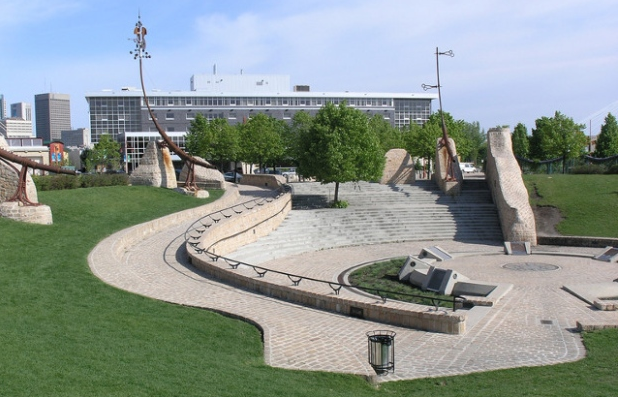
This tour will ‘walk’ you through the birth of our province. First we need to take a step back and understand the background context — the people and places that wove this story. The birth of Manitoba is not a simple story of great “heroes” and “villains”, nor is it it about one event. First we need to understand our rich history and the unique regional culture that’s built the home we have today.
From its earliest days Red River has been a diverse place with competing ideas. The Forks has been occupied by various Indigenous peoples for at least 6,000 years. Some of these groups are Nakoda, Dakota, Anishinaabe, Nehiyaw, Ininew, and many others we can’t name. It was an established meeting place and trade site for very diverse groups. Many people don’t realize that Indigenous trade networks stretched across North America: Pipestone from North Dakota could be traded for pottery from Selkirk or copper and tobacco from Mississippi. All of this travelled along the rivers to this point.
European traders reached Hudson’s Bay in the 1680s, and this land was owned by the Hudson’s Bay Company (HBC) as a corporate colony. Other fur traders working for the rival North West Company (NWC) were already here. Both groups intermarried with the Indigenous population, and there were already well established Metis communities when the first organized European settlers arrived in 1812. These groups set up around the Forks, built competing forts, and simmering cultural conflicts were inflamed by the struggle for valuable furs.
In 1816 the Battle of Seven Oaks between the HBC and NWC tore the Settlement apart. Communities quickly reconciled, but the underlying tensions remained. All of this came to a head after Confederation in 1867, when Canada moved to annex this place before the US could. It’s important to understand that the hard birth of Manitoba in 1870 was not a simple conflict between Metis and settler interests, or a rebellion against the rightful government.
Built in 1864 for Archbishop Tache, with a brick extension and new roof built in 1899. The building was more than just a palace for the Archibishop, it contained offices and lodging for 18 priests. Its architecture is a curious mix of local and imported traditions: It resembles the oldest local log cabins and warehouses, with French Second Empire style dropped on top.
St. Boniface was the French quarter and was treated as a fully independent settlement/city until 1972. Most early maps of Winnipeg do not represent it, even though it’s adjacent to our downtown. The catholic church was one of the most important and powerful institutions in the community from its earliest days. Missionaries from Quebec first arrived in 1818 with Bishop Norbert Provencher, and the community grew around their mission. Red River began as a hub for the fur trade, and its population was overwhelmingly Metis. As the settlement grew and immigration picked up, tensions began to grow between political interests: Some favoured the US, some wanted to join Canada, and others were fiercely independent
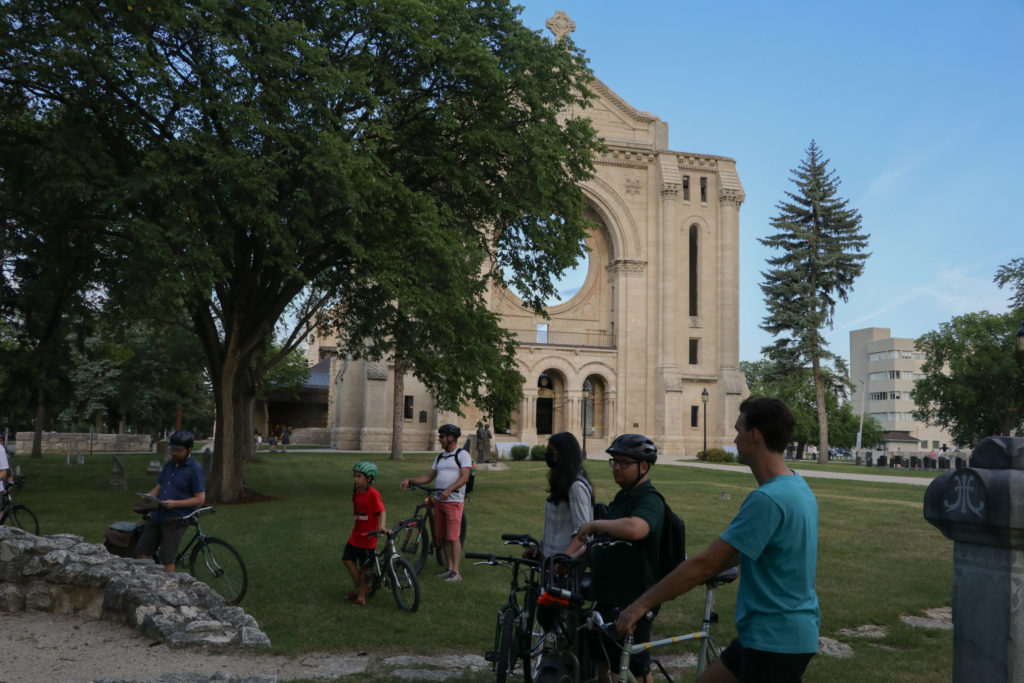
Louis Riel Sr. worked in the fur trade before settling here, and building a mill along the Seine River. In 1849 a local trader was put on trial for violating the HBC’s restrictive trade laws. Riel Sr. organized a group of men to storm the courthouse, armed with rifles, and forced the judge to end the trial. This helped open up trade in the Settlement, and Riel Sr. continued fighting to have Metis & French representatives elected to the local government.
Louis Riel Jr. was born in 1844 and studied to become a priest. He was eventually kicked out of school by the Grey Nuns for constant breaches of discipline, and he began working as a law clerk. He continued the family tradition as a political organizer, advocating vocally for Metis rights and local independent governance. This work eventually culminated in the 1869-70 Red River Resistance and the birth of Manitoba.
Riel was elected as a Member of Parliament, but faced death-threats and fled to the US. He returned in 1885 to lead the North-West Rebellion — another fight for Metis independence in Saskatchewan. This did not end well for Louis, and he was executed for treason by the Canadian government in 1886.
Today Riel is recognized as the “Father of Manitoba”, but he is really one of many: People like James Ross, Pierre Delorme and Ambroise Lepine (who is also buried here) played critical supporting roles in our story.
The Cathedral is also closely associated with infamous characters like Bishop Vital-Justin Grandin. Streets and neighbourhoods in Winnipeg are named for Grandin, but few people know he was the earliest leading advocate of the Indian Residential School system. In 1880 he wrote that these schools would ensure children “forget the customs, habits & language of their ancestors”.

The Grey Nuns arrived in 1844 to establish a mission and convert surrounding communities. The St. Boniface Museum was originally built as their convent in 1846-51, making it the second oldest building in Winnipeg. It also served as the first St Boniface Hospital, and a school. These mission schools taught skills like embroidery to the daughters of prominent fur traders, who were mostly Metis. This mixture of European education and Indigenous arts is one of the major factors that gave birth to our local culture and artforms, like beadwork.
It’s important to recognize what an incredibly multicultural place Red River was at this time. Many people have an idea that this was somehow a British colony from its earliest days, but nothing could be further from the truth. At least five Indigenous nations and diverse Metis groups called this place home. Even the earliest settlers were Scottish, Irish, English, Swiss, Polish, and French Canadian.
Red River even had its own language: Bungee. This regional trade language was a mixture of Scots, Gaelic, Cree and Ojibwe–and it developed so that diverse people could communicate. There was a unique hybrid culture here that is very visible in Manitoba’s early arts and crafts.
The artwork here references the 1852 flood, when the Grey Nuns apparently loaded their cattle into boats and floated them onto the second floor of the convent to survive. This flood devastated the Settlement, but it was a drop in the bucket compared to the flood of 1826.

Upper Fort Garry was first built in 1822, but destroyed by the disastrous flood of 1826, which washed away the entire Settlement. It was rebuilt in 1835 and used as the administrative centre of the HBC’s empire. The Council of Assiniboia (our local government) met here. Winnipeg quickly grew around the fort, and it was demolished in the 1880s to straighten Main street. Check out the interpretive panels and the small piece of original wall.
In 1869 the HBC sold its massive land holdings to Canada for $1.5 million. Of course the local population was not consulted. Some groups here even wanted to join the US. We had long-standing trade connections with Pembina and St. Paul, while Ottawa was very far away. On the other side, the “Canadian Party” were pro-British, generally anti-Metis & anti-catholic. Manitoba’s Population in 1870 was 12,000 — of those 10,000 identified as Metis.
The vast majority of the population felt marginalized, and were concerned that generations of settlement and land claims would not be honoured by the new government. Many disputed that the HBC had the authority to sell their land.
John A Macdonald’s government was not interested in consultation. His concern was connecting the coasts and stopping any possible American expansion. Canadian surveyors arrived to re-survey the land that families had already occupied for generations. Riel’s men blocked them at La Barriere (in St. Norbert) and refused to acknowledge the new governor. Riel’s group then stormed this Fort and took control.
The Governor called on the “Canadian Party” to resist. Some gathered guns around a man named John Christian Shultz, but the majority of settlement opposed them. Most of Schultz’s men were captured and imprisoned in the fort.
Riel convened a Provisional Government, with representatives from across the settlement’s diverse communities. James Ross represented the English-speaking Metis, and he persuaded this group (which did not see eye-to-eye with Riel’s French Metis) that they needed to work together to ensure a future for themselves.
This government wrote a Bill of Rights and outlined their expectations from Ottawa, setting terms to join Canada. A militant Candian supporter, Thomas Scott, was put on trial and executed on Riel’s orders. This decision set off a wave of anger across Canada, and some of Riel’s own government deserted him.
Representatives travelled to Ottawa to negotiate, leading to the Manitoba Act’s signature on May 12, 1870. This established our province, but Canada did not respect most of the rights demanded. There was no amnesty for the Provisional Government: Macdonald dispatched the Wolseley Expedition to put down the “Red River Rebellion”. Soldiers occupied the Settlement, and Riel fled to the US after learning they planned to lynch him.
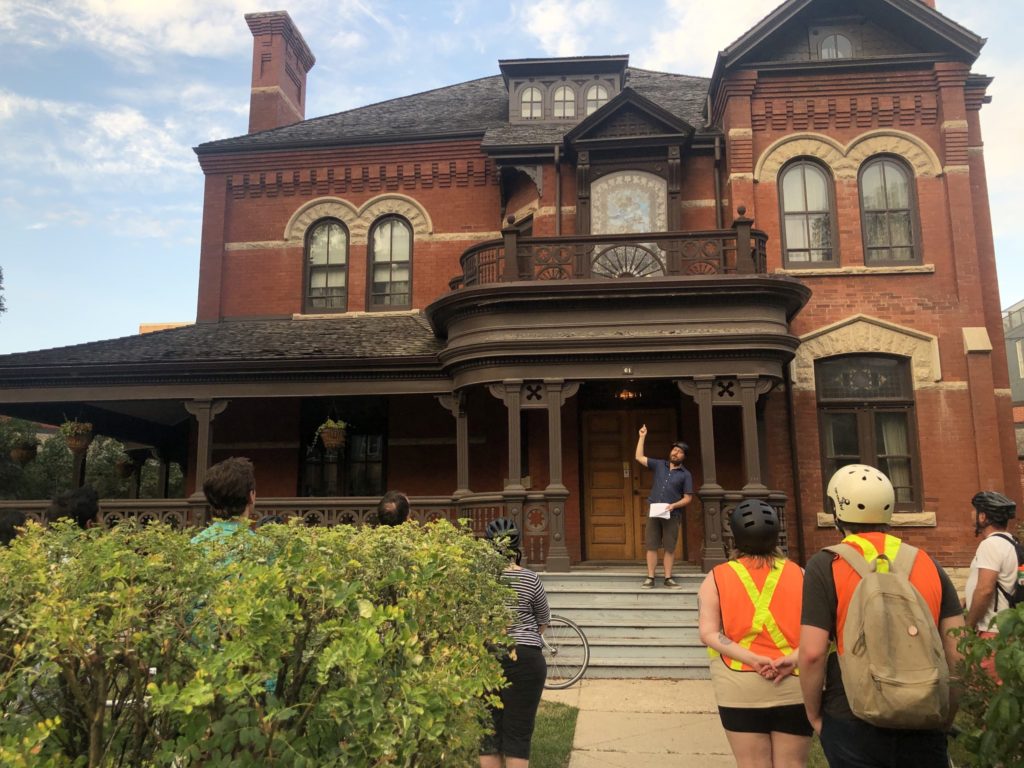
This beautiful Queen Anne style building is also home to some of our city’s ugliest history.Take note of the wonderful stained glass window on the balcony. Dalnavert was built in 1895 for Hugh John Macdonald, the only surviving son of John A Macdonald. Hugh was a lawyer, judge and briefly worked as an MP.
Hugh served as Premier of Manitoba for less than a year, being elected on an aggressively xenophobic, anti-immigrant platform. He advocated stripping citizens who did not speak English of the right to vote, and he pledge to stop the “mongrel hordes” of slavic immigrants from destroying “good British culture” in Manitoba. He also passed prohibition legislation, even though he himself was an alcoholic.
He was the Police Magistrate during the 1919 General Strike, and he personally organized and armed the “Specials”. These were ad-hoc strikebreakers who attacked demonstrators, causing riots and deaths. Hugh aggressively prosecuted striking workers to protect his old-money friends. He also advocated for immigrants that were arrested to be placed in labour camps and deported without trial.
Hugh John first came to Winnipeg after volunteering for the Wolseley Expedition.
Wolseley was dispatched in 1870 to enforce Candian rule and suppress the “rebellious” Metis. Many of the soliders were Orangemen — a militant anti-catholic, anti-French group. Wolseley’s men subjected the community to harassment, beatings, rapes, eventually murdering a postman named Eleazar Goulet. These events were minimized by past historians as small excesses, or part of a necessary police action.
In modern terms this was an intentional campaign of state-sponsored terrorism, designed to ensure that Manitobans forgot their local roots and fell in line with a grand Canadian vision.
Hugh retired from the military, but rejoined specifically to fight Riel & the Metis again at the Battle of Batoche. His story truly comes full circle: Starting and ending his time here with violence against the common people of Manitoba.
This house marks a turning point in Winnipeg’s history, and represents increasing English colonial dominance. This was a time when much of our early history and culture was suppressed, marginalized, and hidden. Metis people call it “Le Temps Noir”, for the generation who hid their identities in shame.
This was a time when we went from a diverse and unique place with an identifiable regional culture, filled with dozens of ethnicities that were so deeply intertwined we created our own local language — to a colonial metropolis, just another stop on the Trans-Canada. This was a time when people fabricated the myth that this place had always been that way — that Indigenous people and traditions were somehow “other” & apart from Manitoba.
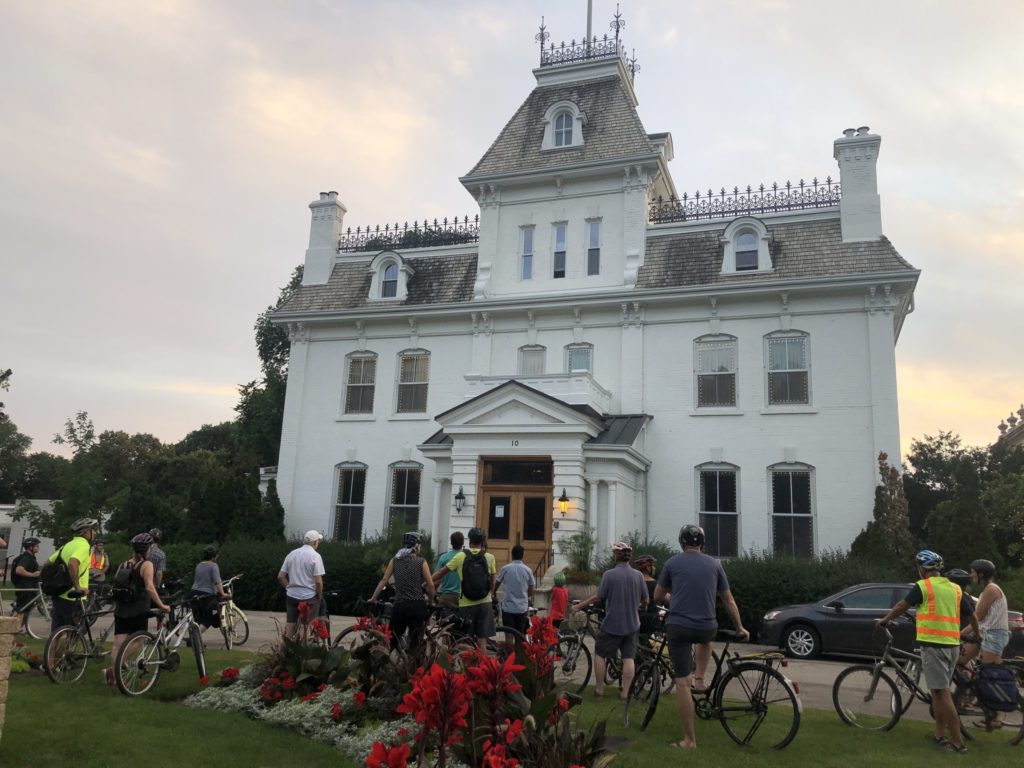
Built in 1883 as a residence for the Lieutenant Governor; it’s now the Queen’s official residence in Manitoba when she visits. It has hosted at least 9 monarchs and members of the royal family. The current plaque calls it “one of few second Empire buildings in Winnipeg” (this isn’t true–take our Beyond la Barriere tour to see many more!). Historically it was not well regarded, in the 1950s it was described as “jarring” and “vaguely Italian”.
In 1870 Manitoba was the “postage stamp province” and barely extended past the current borders of Winnipeg. Canada quickly set about claiming the surrounding Indigenous land by signing Treaty 1 in 1871. The terms of the treaty were disputed from the very beginning. Even at that time the negotiation was generally seen as dishonest, and officials recognized “inside & outside promises” — guarantees made verbally but then intentionally excluded from text. First Nations were confined to reserves without the rights of citizens.
This led to rapid expansion: Winnipeg was incorporated in 1872 and the railway arrived in the 1880s. Urbanization was almost instant and settlers quickly spread across the prairies. Major immigration was encouraged from Canada, the US and Central Europe. The Metis quickly became a minority, increasingly marginalized in their own home. There was increasing institutionalized racism, and a perception of this place as British.
Taking land was one thing, but how did the government avoid another incident like the Resistance? They knew they had to fully destroy a people: economically, socially and culturally. The Indian residential school system was set up to exterminate Indigeneity. Children were forcibly separated from families, abused, and prevented from speaking their own language. This was cultural genocide intended to “destroy the Indian in the child” and meant to make them hate themselves, their parents and their own origins. The goal was complete assimilation.
The ‘scrip’ system gave Metis families small parcels or token payments for their land, but eliminated all future claims. This was meant to extinguish generations of land rights. As more immigrant farmers arrived, Metis communities were forced off their land and settled on the sides of roads. These road allowance communities were seen very negatively — in the 1930s our government started evicting people and burning down their towns to “clean up” the countryside. Areas like this even existed in Winnipeg. Rooster Town was a rough ghetto for our Metis/Indigenous community, and is now being turned into the Parker Land development.
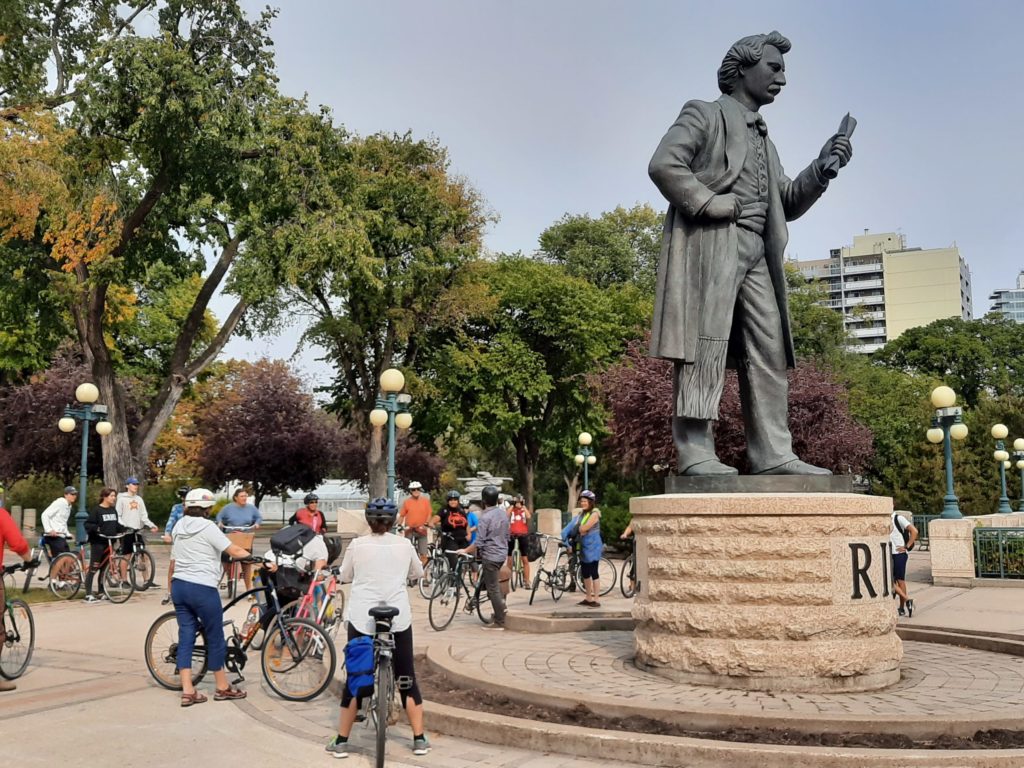
Erected in 1996 to replace an older, more expressionistic statute. The original (installed in the 1960s) was controversial: It showed Riel as a physically twisted and tortured man. The artist intended this to reflect his difficult struggles and mistreatment. Some felt it was not dignified enough, and has since been moved to St. Boniface University..
Even today Riel is largely seen in english Canada as a rebel and traitor, while here he is honoured as the father of Manitoba, and is greatly respected in Quebec.
After 1870 Riel was exiled to the US. At the same time he was elected as our Member of Parliament, but never able to enter the country and take his seat due to threats on his life. In this time his mental health started to suffer, and he began seeing himself as a religious prophet, anointed to succeed Jesus and save the Metis people.
By 1885, Canadian colonization was making its way deep into Saskatchewan. Metis & Indigenous groups under Pîhtokahanapiwiyin (Poundmaker) wanted to resist and asked for Riel’s help. He travelled north and mobilized the population, but many were put off by his new religious focus and strange persona. Still, they organized another resistance.
The North-West Rebellion unfolded very differently than the Red River Resistance.
Resistance quickly escalated to armed threats, blockades and raids — but this time the railroad brought troops from Ottawa almost overnight. On May 9th the government attacked the Metis stronghold of Batoche and crushed Riel’s forces after 3 days of battle. Poundmaker & Riel were both captured and executed, while other leaders fled to the US. This marked the end of organized Indigenous resistance to Canadian expansion.
Prime Minister John A Macdonald demanded Riel’s head in spite of opposition, stating “He shall die though every dog in Quebec bark in his favour”.
Riel was famously quoted as saying “Life, without the dignity of an intelligent being, is not worth having.”
This is our 3rd legislative building, built in 1911-1920 from Tyndall Stone. Its design is very eclectic: It’s covered with neoclassical pediments, gargoyles, and even masonic or occult imagery. The iconic Golden Boy is an imitation of the Greek god Mercury.
The building was meant to embody old-world, neo-classical opulence. There is absolutely incredible symbolism in the building, but this could occupy its own tour. Unfortunately its style and symbolism have absolutely no relationship with any local Manitoban architecture, aesthetics or history. It is a purely colonial European-style structure–and this was not an accident.
Ancient Greece has long been seen as the “cradle of civilization” and the origin of European culture. It was an intentional choice to model the seat of power in Manitoba after this. It is a symbol of colonial power and was meant to suggest its role as a “civilizing” centre on the wild prairies. Check out our Across the Assiniboine tour to learn more about the architecture of settlement.
The building was also a massive corruption scandal which brought down the sitting Conservative government. The builder was close friends with government officials, and he doubled the project’s cost after stealing most of the materials to build his own mansion nearby.

This statue of Queen Victoria was unveiled in 1904–60 years before Riel’s. It was designed by the English sculptor George Frampton.
As Queen of Canada, Great Britain, and Empress of India, Victoria controlled the largest colonial empire in history. Today her image is extremely controversial, and she is seen as one of the greatest symbols of colonial violence and oppression in Canada. In the spring of 2020 red paint was thrown over this statue in protest.
It’s worth asking: Is she an appropriate symbol for the front of Manitoba’s legislature? This is a place of great honour and significance. Do we believe that she should be the public face of our province? Victoria never once set foot in Manitoba.
Even for those of us with settler roots, I think we need to ask what she really represents to us. I know that she does not represent my Manitoba. To me she also represents colonial violence.
My ancestors, like the first settlers that arrived in 1812, were poor Scottish folk. Those settlers were fleeing oppression by English nobles back home. It must be remembered that the colonizers of this place were themselves colonized first by the English in a repeating cycle of violence and exploitation. This is truly the definition of inter-generational trauma–and most of us suffer from it to one degree or another.
These statues are not neutral reminders of history, they are celebrations of a certain perspective. We need to understand all points of view around them, and we need to actively use them to provoke discussion and reflection on our past.
This is the only way we can do better for each other and build a stronger home for the future.
Google MyMaps Link
The Pedal into History project was supported by contributions from the Province of Manitoba through the Heritage Grants Program., the City of Winnipeg, and Seven Oaks House Museum. We are grateful for their support.

